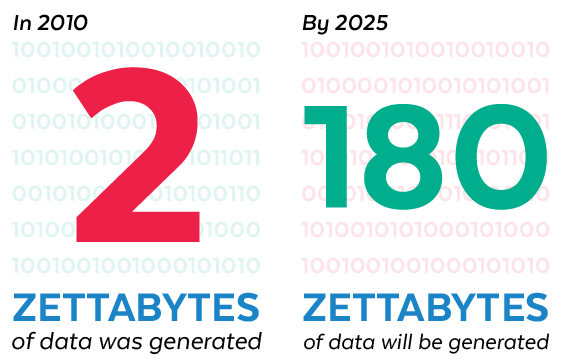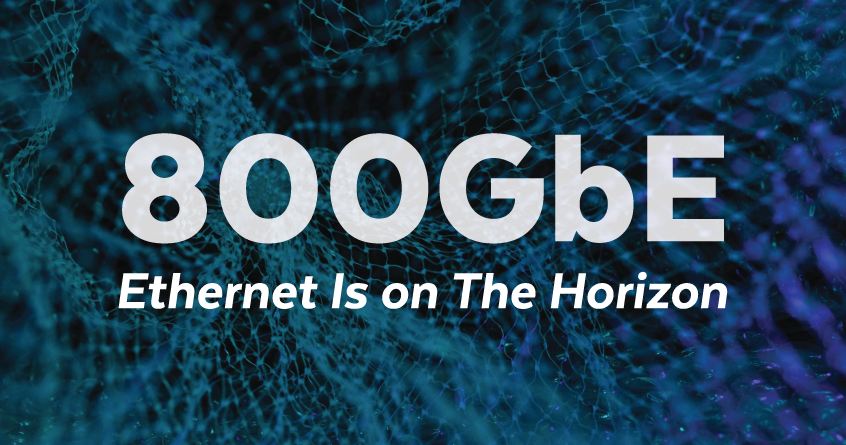What Is It, How Does It Work, and How Is It Better (Than What We Have Now)?
The original Top Gun movie came out in 1986. In the same year, the first IEEE ethernet standard was published. At the time, no one saw Maverick’s iconic line, “I feel the need for speed,” as a sign of things to come. Yet 50 years later, the driving force in Ethernet development is the need for speed. Distributed systems, remote workers, and the Internet of Things (IoT) have pushed the demand beyond 200 and 400 Gbe capabilities to 800 Gbe. Considering that a 5G network delivers a maximum of 10 Gbps, it’s hard to imagine the impact 800 Gbe will have once it’s out of development.
What is Gigabit Ethernet?
Most ethernet networks use the fast Ethernet (FE) standard, which supports 10/100 Mbps transmission rates. Gigabit Ethernet (GE) requires hardware that supports gigabit per second transmission rates of 1000 Mbps. The 10 Mbps Ethernet cable codes one bit of data per signal on a twisted pair. At 100 Mbps, data is grouped into eight bits and sent over a 10-bit signal. Both speeds use only two of the cables, four twisted pairs.
When using GE, two bits of data are transmitted per signal, and all four pairs are utilized. The coding change and the four-pair use allow more data to be sent over the same eight-wire cable. Unlike FE, where one wire pair is used to send and another to receive data, GE uses all four pairs for bi-directional transmissions. The implementation allows FE and GE to use a Cat5 cable, although Cat5e is recommended for GE as it has less crosstalk than a Cat5.
 GE and PoE
GE and PoE
Power over Ethernet (PoE) sends electrical power over an Ethernet cable. This technology can use the spare pairs in a 10/100 Mbps cable, or it may use the data pairs. Because GE uses all four twisted pairs, high-powered PoE sends power up to a maximum of 100W through four twisted pairs.
800 Gbe
An IEEE assessment conducted in 2020 suggested that bandwidth demands will grow to 55.4 times the level of demand in 2017. To address this increase, the IEEE created two working groups to study the growing need for faster Ethernet capabilities. One group will focus on 400 and 800 Gbps solutions, while the second will include 200, 400, and 800 Gbps and 1.6 Terabit per second requirements. The 400/800 task force will look to leverage existing 100 Gbps technologies for 800 Gbe.
Is There a Demand for 800 Gbe?
The world generated two zettabytes of data in 2010. By 2025, it is estimated that the amount of data will exceed 180 zettabytes. While not all of this data will be stored, a significant portion will be transmitted. This transmission may occur through the cloud or a server and may be sent to multiple endpoints. As the amount of data being generated continues to increase, technology must keep pace by transporting this data at equal or faster speeds.
Commercial enterprises have a growing need for faster transmission of more data to meet their business objectives. Companies need technology capable of supporting a distributed workforce and an ever increasing number of Internet of Things (IoT) devices. They’ll also need the capacity to deliver data for artificial intelligence solutions and big data analytics.
IoT
With the expectation that nearly 42 billion active IoT devices will have been deployed by the end of 2023, the world will continue to demand faster data transmission speeds. Even companies adopting edge computing will want more data processed in less time. While organizations move data processing efforts closer to data sources for faster response times, they’ll expect their infrastructure to keep pace as the number of devices increases.
Remote Workforce
Remote work isn’t going anywhere. 98% of the American workforce wants to work remotely, at least part-time. For companies, this means there is a significant impetus for creating an infrastructure that supports a hybrid work model. It means having the necessary bandwidth to handle video and large file transfers. Without high-speed transfer rates, a marketing video would take hours to download and play, even within an office setting.
Distributed Networks
College and corporate campuses no longer rely on large centralized data centers. Most organizations now distribute their data processing needs across the enterprise. Research facilities archive volumes of data that may be sent across the country or to the lab across campus. Employees may need to share large graphic files with co-workers down the hall. Employees can only take so many coffee breaks waiting for data to download.
Advanced Technologies
Although data may be collected at the edge, artificial intelligence (AI) and data analytics need aggregated data to deliver insights and customized experiences. These types of business objectives require faster processing power and data transfer rates. With increased capabilities of ingesting unstructured data, the information sent across network connections will only grow as the consumption of images, videos, and graphics increases.
What Are the Challenges of 800 Gbe?
While end users want 800 Gbe technology, IEEE standards are still uncertain. The Ethernet Technology Consortium released its 800 Gbe specifications in April 2023. Potentially conflicting standards may create compatibility issues moving forward. In some situations, early versions of the technology may not support features such as auto-negotiation or link training.

Image Source: Ethernet Alliance
Chips
The chip shortage of 2021 saw a backlog of orders in the automotive and manufacturing sectors. While the chip shortage is easing, the industry continues to deliver mature technology that is at least 15 years old. Only 17.5% of manufacturers are looking to support advanced technologies. Mature chip technology will not address the need for faster switch chips to increase lane speeds.
Transceivers
Optical transceivers generate heat. 800 Gbe transceivers produce lots of heat that can interfere with transmission integrity. At higher temperatures, electrons move faster, creating more opportunities for external noise and crosstalk. Signal strength degrades at higher temperatures, making shorter runs a necessity. Operational parameters are a hurdle that 800 Gbe must surpass.
Network Equipment
Nothing frustrates end users more than incompatible equipment. Without an accepted standard, early adopters may pressure manufacturers to deliver equipment that will not fully support the final standards. With conflicting network devices, implementing 800 Gbe technology may prove costly when equipment becomes obsolete.
Versa Technology
Versa Technology, Inc. is an industry leader in Power over Ethernet (PoE) solutions. Our commitment to delivering cutting-edge PoE solutions to the worldwide market remains unwavering, as the need for lightning-fast Ethernet shows no signs of slowing down.

